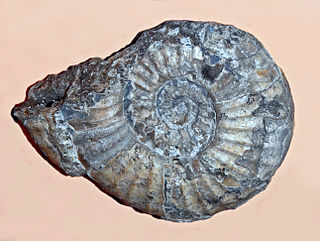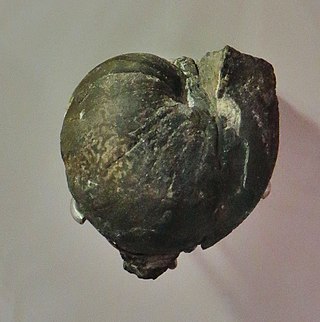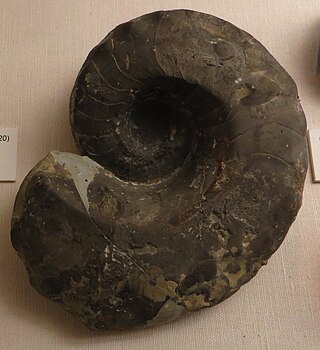
Aturia is an extinct genus of Paleocene to Miocene nautilids within Aturiidae, a monotypic family, established by Campman in 1857 for Aturia Bronn, 1838, and is included in the superfamily Nautilaceae in Kümmel 1964.

Cenoceras is an extinct genus within the cephalopod mollusc family Nautilidae, which in turn makes up part of the superfamily Nautilaceae. This genus has been described by Hyatt in 1884. The type species is Cenoceras intermedium, which was originally described by Sowerby 1816 as Nautilus intermedius.

Psiloceratoidea is a superfamily of Early Jurassic ammonoid cephalopods proposed by Hyatt in 1867, assigned to the order Ammonitida. They were very successful during Hettangian and Sinemurian. Last of them, family Cymbitidae and genera Hypoxynoticeras and Radstockiceras survived into Early Pliensbachian.
Permoceras, the sole member of the family Permoceratidae, is a genus of coiled nautiloids with a smooth, compressed involute shell, whorls higher than wide, earlier whorls hidden from view. The venter is rounded as are the ventral and umbilical shoulders, the flanks flattened. The siphuncle is ventrally subcentral. The suture, which is most characteristic, has a deep, narrow pointed ventral lobe and large, asymmetrical pointed lobes on either side.
Tithonoceras is a genus of nautiloid cephalopod from the Upper Jurassic found in the Crimea, belonging to the nautilacean family Paracenoceratidae.
Heminautilus is an extinct genus of nautiloids from the nautilacean family Cenoceratidae that lived during the Early Cretaceous. Fossils of Heminautilus have been registered in rocks of Barremian and Aptian age. Nautiloids are a subclass of shelled cephalopods that were once diverse and numerous but are now represented by only a handful of species.
The Clydonautiloidea are a superfamily within the nautiloid order Nautilida characterized by smooth, generally globular, shells with nearly straight sutures, in early forms, but developing highly differentiated sutures in some later forms. Where known, the siphuncle tends to be central to subcentral.

The Trigonoceratoidea are a superfamily within the Nautilida that ranged from the Devonian to the Triassic, thought to have contained the source for the Nautilaceae in which Nautilus is found.
Syringonautilidae is a family of Nautiloidea from the middle to late Triassic. Syringonautilidae comprise the last of the Trigonoceratoidea and are the source for the Nautilaceae which continued the Nautiloidea through the Mesozoic and into the Cenozoic right down to the recent. Syringonautilidae is a strictly Triassic family, derived early in the Triassic from the Grypoceratidae.

Grypoceratidae is the longest-lived family of the Trigonoceratoidea, or of the near equivalent Centroceratina; members of the Nautilida from the Upper Paleozoic and Triassic.
The Centroceratidae is the ancestral family of the Trigonoceratoidea and of the equivalent Centroceratina; extinct shelled cephalopods belonging to the order Nautilida
The Naedyceras group comprises three similar and closely related openly coiled, gyroconic, genera within oncocerid family, Brevicoceratidae: Naedyceras, Gonionaedyceras, and Gyronaedyceras.
Aphelaeceras is an extinct genus from the nautilid family Trigonoceratidae which is part of the Trigonocerataceae, that lived during the Mississippian Period in the late Paleozoic.
Condraoceras is a genus of liroceratids from the Pennsylvanian of North America and Lower Permian of Europe with a compressed, involute, nautiliconic shell; subcircular whorl section; small umbilicus with a rounded shoulder; suture with shallow ventral and lateral lobes; and narrow subcentral siphuncle.

Peripetoceras is a genus in the Clydonautilacean family, Liroceratidae. It can be recognized by its smooth, involute shell with a deep small umbilicus with rounded shoulders and steep convex wall; whorl section with flattened venter, rounded ventral shoulders and convergent slightly convex flanks; suture with slight ventral and lateral lobes; and small siphuncle located dorsally of the center.
Siberionautilidae is a family in the nautilid superfamily Clydonautiloidea that contains only the genus Siberionautilus, which comes from the Upper Triassic (Carnian) of Siberia, Russia.
Enoploceras is a Tainoceratid genus, a nautiloid cephalopod in the order Nautilida, known from Triassic sediments in Europe, India, Timor, and the state of Idaho.
Cymatonautilus is a genus of cymatoceratids from the middle and upper Jurassic of Europe, the Middle East and Asia characterized by a robust shell with a wide umbilicus and subquadrate whorl section, slightly wider than high. The flanks and venter are flattened. The flanks have a wide lateral groove; the venter a more narrow median groove. The suture has a shallow ventral lobe and broad concave lateral lobes, crossed obliquely by sinuous ribs that produce a deep ventral sinus. The siphuncle is subcentral.
Grypoceras is a coiled nautiloid cephalopod from the Triassic of western North America, southern Asia, and Europe that belongs to the nautilid family Grypoceratidae. Named by Alpheus Hyatt in 1883, the shell of Grypoceras is essentially involute with a subtriangular cross section, widest across the umbilical shoulders, with flanks fairing toward a narrow flattened venter. Sutures on flanks are with smooth, deep lobes and with shallow ventral lobes.

Germanonautilus is a cephalopod genus included in the nautilid family Tainoceratidae, found widespread in the Triassic of North America, Europe, Asia, and north Africa. The shell is a moderately involute nautilicone ; whorl section subquadrate to trapezoidal, widest across the umbilical shoulders, flanks flattened and ventrally convergent, venter flat and wide, dorsum narrowly and deeply impressed. The suture is with broad and deep lateral lobes and a shallow ventral lobe. The siphuncle is central and nummuloidal, composed of expanded segments that give a beaded appearance.





